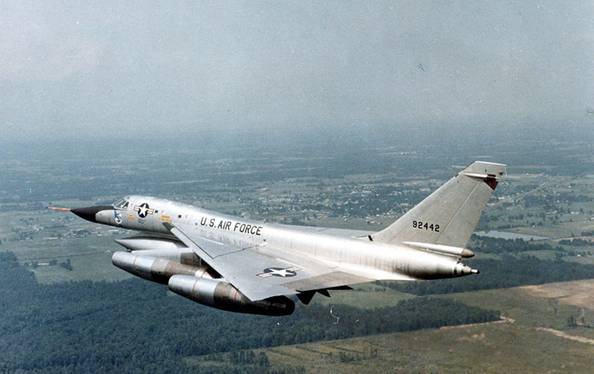B-58 FACT SHEET
By Cliff Lethbridge

B-58
Launch Status: No Longer Used for Cape Canaveral Missile Launches
First Cape Canaveral Launch: September 5, 1958
Final Cape Canaveral Launch: June 4, 1959
Total Number of Cape Canaveral Launches: 3
Vehicles Launched: ALBM-199C
Function: Strategic Medium Bomber
Contractor: Convair Division, General Dynamics Corporation
Power Plant: Four GE J-79 Turbojets with Afterburner
Power Plant Thrust: 10,000 pounds each engine plus afterburner
Wingspan: 56 feet, 10 inches
Length: 96 feet, 9 inches
Height: 31 feet, 5 inches
Speed: Mach 2 (1,324 m.p.h.) at 35,000 feet
Ceiling: 60,000 feet
Range: Intercontinental (with aerial refueling)
Bomb Load/Cargo Capacity: Nuclear Weapons in Disposable Cargo Pod
Armament: T-171E3 20-millimeter cannon
Crew: Three (Pilot, Bombardier/Navigator, Defensive Systems Operator)
Maximum Gross Takeoff Weight: 160,000 pounds
Primary Using Command: Strategic Air Command
The B-58 “Hustler” was the world’s first supersonic bomber. Designed as a strategic bomber and reconnaissance weapon, the B-58 was first flown in November, 1956. An impressive technical achievement, the B-58 produced performance improvements over the fastest existing bombers equivalent to the previous 50 years of aircraft design and manufacture.
Designed using a “minimum size” concept, the B-58 employed a wasp-waisted fuselage and a disposable weapons pod under the aircraft rather than an expansive cargo bay inside the aircraft. Both the weapons payload and some fuel for the aircraft was carried in the disposable pod, vastly improving the bomber’s performance by eliminating a need for it to carry empty space after weapons were deployed or fuel was depleted. Dropping the pod dramatically increased the survivability of the B-58 in a hostile situation.
The struts of the B-58 landing gear were unusually long compared to other bombers in order for them to safely clear the weapons pod. In addition to weapons and fuel, the pod could carry cameras or electronic countermeasure equipment. A B-58 aircraft was modified to carry a prototype Air-Launched Ballistic Missile (ALBM) prototype named ALBM-199C. In this application, the B-58 was flown out of Eglin Air Force Base, Florida over Cape Canaveral waters. The ALBM-199C was dropped from the B-58 and fired over open Atlantic Ocean waters.


